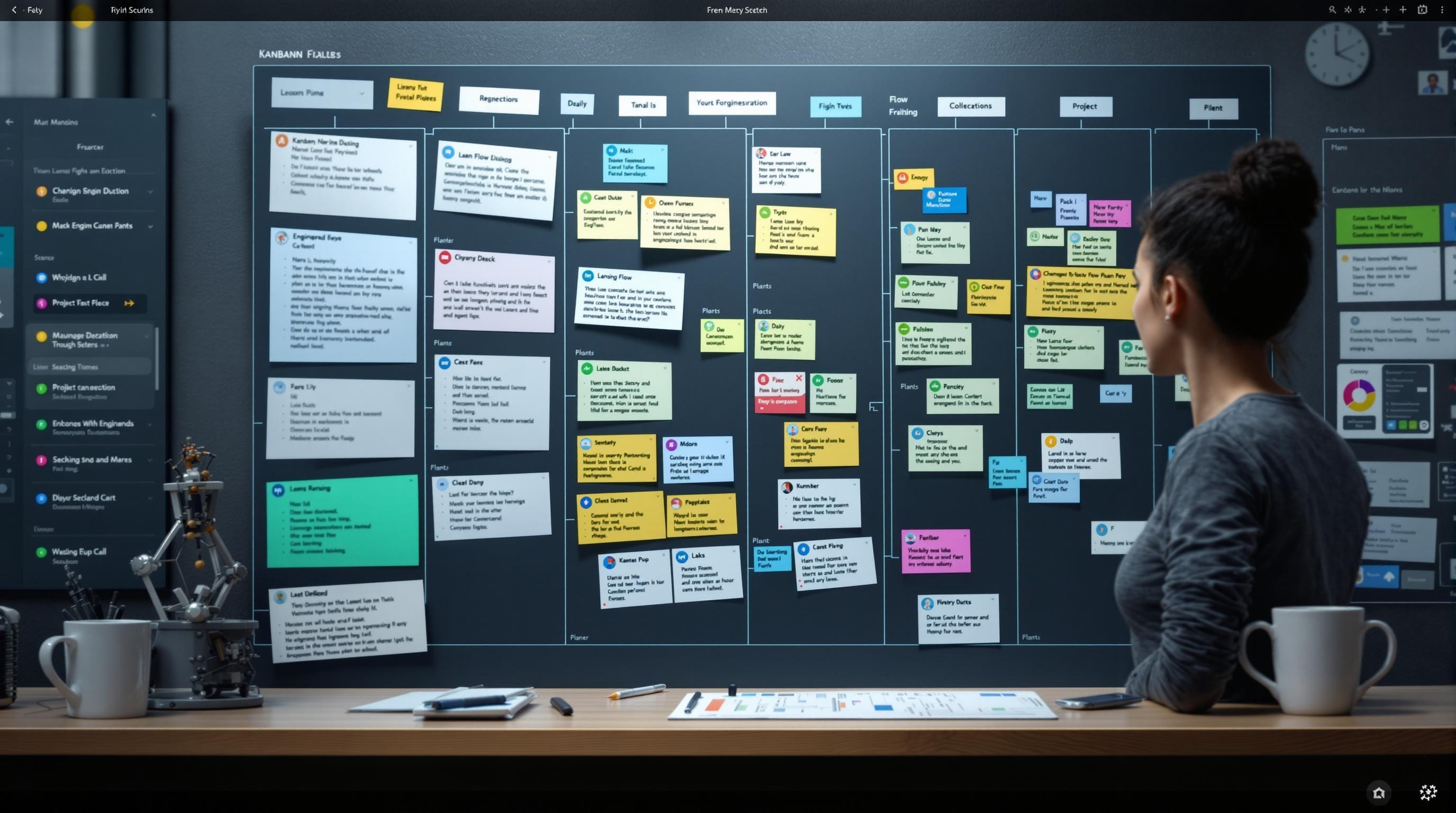Japanese learning philosophies deliver powerful, research-backed strategies that speed up skill acquisition and boost retention.
How Japanese Learning Philosophies Accelerate Skill Mastery
Kaizen’s focus on steady, incremental progress and Shoshin’s emphasis on cognitive flexibility set the stage for rapid improvement. Kanban’s visual organization and Ikigai’s purpose-driven motivation keep learners engaged and moving forward. By blending these seven proven techniques—Kaizen, Shoshin, Pomodoro, Spaced Repetition & Active Recall, Ikigai, and Kanban—learners worldwide can sharpen their focus, deepen their understanding, and make consistent progress in both academic and professional settings.
Key Takeaways
- Kaizen’s microlearning and habit stacking build retention and fight the forgetting curve with daily, manageable steps.
- Shoshin’s beginner’s mind approach encourages curiosity and mindfulness, fueling neuroplasticity, reducing bias, and speeding up problem-solving.
- The Pomodoro Technique uses chronobiology to sharpen focus, cut distractions, and help fit effective study sessions into a packed schedule.
- Spaced repetition and active recall, especially with digital tools, dramatically improve long-term memory and learning efficiency.
- Ikigai and Kanban keep motivation high and productivity steady by connecting learning to personal meaning and making tasks visually clear for a smoother workflow and faster results.
Kaizen: The Science of Incremental Progress for Lifelong Learning
Kaizen: The Science of Incremental Progress for Lifelong Learning
Adopting the Kaizen philosophy means embracing small, consistent improvements every day. Research shows that microlearning—an approach rooted in Kaizen—can boost retention by 40% over six months compared to traditional study methods. This directly addresses the “forgetting curve,” which reveals that up to 70% of new information can be forgotten within just 24 hours. To counteract this, I recommend scheduling short, focused learning sessions of 5–15 minutes daily.
Across Europe, vocational programs—especially in healthcare—are already seeing the benefits of Kaizen-inspired microlearning. Platforms like Osmosis and Skillsoft deliver content in bite-sized segments, a method supported by Cedefop’s findings that 13% of EU workers still need stronger digital skills. In Germany, vocational schools use Blinkist-style micro-courses for manufacturing apprentices, closing skill gaps and reinforcing the power of habit formation—a process that, on average, takes at least 66 days of repeated effort.
Practical Tools and Strategies for Kaizen-Based Microlearning
To ensure incremental progress becomes a lasting habit, I rely on proven tools and techniques that support both retention and habit stacking. Here are some top recommendations for effective microlearning and continuous improvement:
- Use spaced repetition apps like Anki and Quizlet to create custom flashcards, making review sessions quick and effective.
- Stack learning habits with daily routines; for example, pair a 10-minute micro-course on Skillsoft with your morning coffee.
- Try Blinkist-style summaries to distill complex topics into digestible pieces, ideal for busy schedules.
- Track your progress and reward consistency—habit formation strengthens when you recognize milestones.
Embracing Kaizen through microlearning tools ensures you’re not just consuming information, but truly mastering new skills one step at a time. Start small, stay consistent, and watch your learning compound.

Shoshin: Cultivating the Beginner’s Mind to Boost Cognitive Flexibility
Adopting Shoshin, or the beginner’s mind, means approaching each subject with genuine curiosity and a willingness to question assumptions. This Zen Buddhist principle encourages us to let go of preconceived notions, even if we’re already skilled in an area. A 2024 University of Amsterdam study found that those who practiced Shoshin solved intricate problems 25% faster than others, highlighting the technique’s power to boost cognitive flexibility.
Shoshin also helps combat the Einstellung effect, which is the tendency to default to familiar strategies even when new ones would work better. For example, programming students who embraced Shoshin reduced this effect by 30%, opening the door to greater neuroplasticity and adaptability.
To put this mindset into action, European coding bootcamps like Le Wagon integrate “unlearning” challenges every week to keep minds agile and receptive. Meanwhile, Swedish schools have seen STEM retention rise by 20% after adding Zen meditation breaks—clear proof that a mindful approach can transform learning outcomes.
Strategies to Adopt the Beginner’s Mindset
- Release judgment about your expertise and allow new perspectives.
- Practice curiosity by regularly asking open-ended questions.
- Engage in mindfulness exercises to reduce distractions.
- Reflect on what assumptions you hold before starting a task.
Tools for Fostering Openness and Focus
To foster openness and focus, I recommend tools like Headspace for guided mindfulness sessions and Forest for maintaining concentration. These apps are widely used in European educational circles, helping learners stay present and flexible as they tackle new challenges.

Pomodoro Technique: Harnessing Chronobiology for Peak Focus
The Pomodoro Technique breaks work into 25-minute bursts, separated by short breaks. This method, rooted in Japanese time management principles, leverages your natural ultradian rhythm—which cycles every 90–120 minutes—to keep your brain at peak performance.
With Pomodoro, you’ll notice a real difference in your ability to concentrate. Produce8 data shows Pomodoro users consistently reach 90% focus scores, far above the 63% baseline. Such sustained attention can transform how you approach demanding study sessions or complex projects.
Why Pomodoro Works for Learning
Here are the main benefits you’ll experience by using the Pomodoro Technique:
- Sharpens focus: Focus@Will, a French productivity app, found that EU users experience 22% fewer task switches when following Pomodoro intervals. Fewer interruptions lead to deeper engagement with your material.
- Boosts memory: Research from the Karolinska Institute reveals that taking a five-minute walk every 90 minutes—aligned with ultradian rhythms—can increase hippocampal activity by 15%, supporting both learning and memory.
- Fits busy schedules: With 25-minute intervals, you can slot Pomodoro sessions between meetings or classes, maximizing short windows of time.
For extra support, tools like Toggl Track (which respects EU data rules) and PomoDone (integrated with LinkedIn Learning) make it easy to stick with the technique. These apps help you time your intervals, track your progress, and sync your learning goals across platforms.
I encourage you to try Pomodoro—whether you’re prepping for exams, mastering new skills, or simply aiming to get more done without burning out. The science and the numbers speak for themselves.

Spaced Repetition & Active Recall: Building Lasting Memory Through Cognitive Scaffolding
Mastering Memory with Spaced Repetition and Active Recall
Spaced repetition and active recall are at the core of efficient Japanese learning strategies. Medical students applying these methods score 34% higher on licensing exams, demonstrating their effectiveness. By reviewing material at optimal intervals—such as 24 hours, 7 days, and 30 days—you can cut your relearning time in half. This approach aligns with the Ebbinghaus forgetting curve, which shows how strategic review combats memory decay.
Active recall involves testing yourself rather than simply rereading notes. This process strengthens synaptic connections, making it easier to retrieve information when needed. Combining both techniques transforms short-term facts into lasting knowledge. For instance, Spanish learners using Memrise’s interleaved modules—where topics are mixed instead of blocked—progress twice as fast compared to block learning.
Practical Tools and Strategies for Lasting Results
To put these techniques into practice, consider digital tools designed for effective retrieval practice and synaptic consolidation. Here are some options that support spaced repetition and active recall:
- Anki: Widely used by the UK’s National Health Service for nurse training, Anki’s flashcard system leverages spaced repetition automatically.
- RemNote: Designed with GDPR compliance in mind, RemNote is a solid choice for European learners focusing on privacy and efficiency.
- Brainscape: This platform offers specialized exam decks for focused retrieval practice, making it a favorite among those preparing for professional tests. Brainscape
By optimizing your review intervals and using retrieval-based tools, you ensure that learning sticks. Embrace interleaving—mixing different topics—in your study sessions to further boost retention and adaptability. Making these techniques a habit will help you master new material faster and retain it longer.

Ikigai: Finding Purpose for Sustainable Motivation and Learning
Ikigai—meaning “reason for being”—is a powerful motivator for anyone aiming to accelerate their learning. By aligning what excites you with your natural talents and the needs of your community, you create a feedback loop that fuels both progress and satisfaction. I’ve witnessed how finding this alignment transforms learning from a chore into a lifelong pursuit.
Practical Strategies for Purpose-Driven Learning
To harness Ikigai for faster, more sustainable learning, consider these approaches:
- Reflect on your passions and strengths. Tools like StrengthsFinder, used at KU Leuven, help students pinpoint what they’re naturally good at and have reduced course abandonment by 18%.
- Seek context that connects your skills to broader goals. Komatsu’s European traineeships, which tie heavy machinery training to the UN Sustainable Development Goals, have increased completion rates by 40%.
- Choose workshops and assessments that foster psychological safety. Platforms such as TalentLens (Pearson) and Mindvalley provide structured environments where you can explore your purpose and strengths without fear of judgment.
- Prioritize learning environments that support purpose-driven growth. Adobe engineers who embraced Ikigai principles reported 31% less burnout, proving that purpose isn’t just a buzzword—it’s a practical tool for resilience and motivation.
Don’t underestimate the impact of aligning your study or work with a deeper purpose. Purpose-driven learning, grounded in strengths and societal impact, creates an environment where you’re less likely to burn out and more likely to thrive. If you want to supercharge your learning, start by asking yourself why your goals matter, then use strengths-based tools to chart your own path.

Kanban transforms how I approach projects by making every task visible and manageable. Instead of juggling responsibilities in my head, I lay them out on a board—physical or digital—so progress and bottlenecks become obvious. This visual clarity helps me focus and prioritize with purpose, ensuring that nothing slips through the cracks.
Kanban & Visual Organization: Engineering Flow States for Project Success
Key Elements of Kanban for Enhanced Learning and Productivity
To get the most out of Kanban and related visual systems, focus on a few proven strategies:
- Visualize Every Task: Use columns labeled “To Do,” “In Progress,” and “Done” to keep your workflow transparent. It’s easy to spot where things stall.
- Limit Work-in-Progress: Cap the number of active tasks per column. Munich tech startups limiting WIP to 3–4 tasks per stage have cut cognitive overload by 27%. This keeps you engaged but never overwhelmed.
- Enable Fast Feedback: Integrate the Andon Cord approach. In Italian design schools, color-tagging—red for urgent issues, yellow for cautions, green for go—lets teams address obstacles right away.
- Map Value Streams: Lay out each step from idea to completion. You’ll quickly see where effort adds value and where waste creeps in.
- Automate and Template: Platforms like Trello (especially with Butler automation) and Notion (with EU academic templates) help streamline recurring tasks and standardize project management. These tools are favorites in both European classrooms and tech firms.
I’ve seen Kanban boards help teams at Leuphana University finish projects 2.1 weeks early. By making work visual, setting clear limits, and responding instantly to snags, I consistently hit flow states—where productivity feels effortless and progress is measurable. Try these methods, and you’ll likely see your learning speed up as well.

In summary, integrating Japanese learning philosophies like Kaizen, Shoshin, Pomodoro, Spaced Repetition, Ikigai, and Kanban can revolutionize your approach to education and personal growth. By combining incremental progress, curiosity, mindful focus, strategic review, purpose, and visual organization, you’ll not only learn faster but also retain more and find greater satisfaction in the journey.
Ready to transform your learning? Start applying one of these strategies today and experience the difference for yourself!
Sources:
Cedefop, Cedefop Skills Mismatch Report (2023)
Karolinska Institute, Karolinska Institute Chronobiology Study (2024)
University of Amsterdam, University of Amsterdam Cognitive Flexibility Research (2024)
Shunryū Suzuki, Zen Mind, Beginner’s Mind
Komatsu, Komatsu EU Traineeship Case Study (2025)
Leuphana University, Leuphana University Kanban Implementation Report (2023)
Produce8, Produce8 Pomodoro Data (2023)
NHS Employers, NHS Anki Nurse Training
KU Leuven, KU Leuven StrengthsFinder
Focus@Will, Focus@Will European User Study
Memrise, Memrise Interleaving Research
Brainscape, Brainscape Exam Data
Mindvalley, Mindvalley Purpose Workshops
Trello, Trello for Education
Notion, Notion EU Academic Templates










